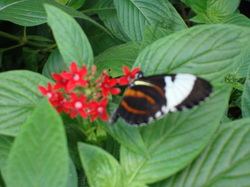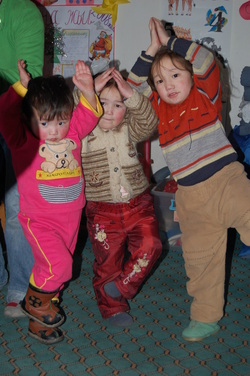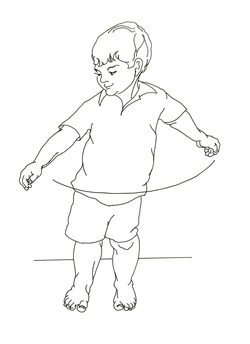Wouldn't it be glorious if we could fly? Well we can, just close your eyes and imagine yourself the most beautiful butterfly you have ever imagined you could be. Begin your adventure by flying to the top of a swing set and looking over the yard to watch the children playing. Swoop above each child being sure to flicker your wings in their vision. As they follow your colorful swirling you take them to the edge of a gulley where a rope swing awaits them. Each child takes a turn pushing a friend out over the gulley as they laugh with excitement.
Soon the children are following the quick flap of colorful wings over to the best climbing tree in town. Each child climbs to a low branch where they sit and watch the butterfly do a colorful dance through the air. From here the butterfly guides you through a field of wild flowers with colors of pink, purple, blue, orange and yellow. Each place the butterefly leads you becomes an experience that feels as if it is real.
Encourage each child to describe their wings and let them add the next place the butterfly will lead you.
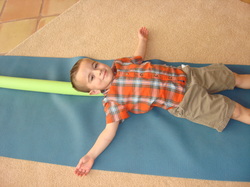
Yoga Journal recently shared a suggestion to lie on a swimming pool noodle to encourage chest expansion. As I am always interested in new ways to encourage heart opening while stimulating potential for greater respiration, I tried it! Love, love, love this restorative pose as it energetically opens the heart and physically provides extension and expansion for deeper breathing.
While your child is sitting on the mat, place the noodle in back of them and have them lie down and align their back and head on the noodle. Be sure this is comfortable for the child as you may wish to slightly slide the noodle up away from the sacrum
Best bit of news is that Tundra is selling small noodles that are perfect for little backs. Three minutes seems to do just fine. Please let me know if you receive extra hugs from this heart opening pose.
I recently engaged young students in a game of "At the Zoo". We visited various animals and while we discussed the many attributes of the animal we struck the yoga pose that was most like that animal. For zebra we did horse pose and for flamingo we did tree pose. On and on the children were able to find a yoga pose that resembled each animal, even if not finding a pose that directly was labeled as such.
How did we travel to the zoo? Why, helicopter, ofcourse :)
I am always upliften or enlightened when I read John-Rogers book excerpts. Here is one I find highly interesting
"Daydreaming is not necessarily a waste of time. For example, it can be quite useful for giving a person time to manage their emotions through getting away from a source of emotional difficulty. Daydreaming also permits the creative elements to fuse and produce more easily without the conscious self (a person's usual, everyday self), ego, and judgment in the way. Part of the creative process involves putting those aspects aside so that the creative forces can flow freely.
The structuring comes in later when you translate the vision into something tangible. Einstein daydreamed, as did Edison and many other creative, inventive people.
Adults often do not feel comfortable calling it daydreaming, however, so we invented another, more mature word - preoccupation.
Children often daydream, and when a student is daydreaming in class, instead of saying to stop it, a better approach is for the teacher to ask the student to write or draw what they are seeing.
John Roger
(from: Fulfilling Your Spiritual Promise, p. 25-26)
I recently met a young woman who imports products from Mongolia to benefit children in that country. She loves yoga and is studying in her second year as a speech therapy graduate student.
Here are her little friends in Mongolia doing something they love :)
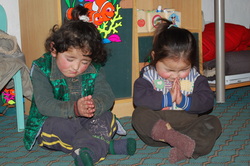
Mudras, or sacred finger and hand postures, are fun for children and especially appropriate for children who are working on communication and fine motor skills. I have worked with early childhood sign language for years and my favorite sign is the one used to express "I Love You." I teach this mudra first and it sets the tone for all else to come.
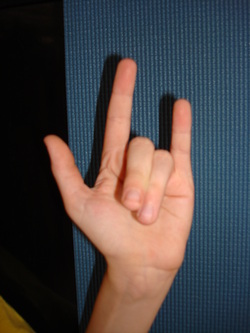
I frequently rename yoga poses when working with a theme for children's yoga classes. Just recently I used the photograph of pink flamingos that a friend of mine sent from Tanzania. It was simple to ask the young students I work with to stand like a flamingo. We simply adopted tree pose to carry out this imaginative imitation of the photograph.
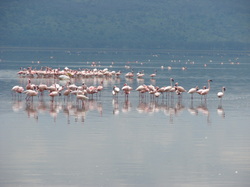
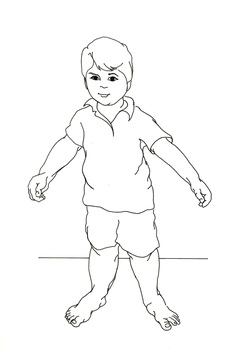
I have discovered that children can begin to understand what it is all about to stand on one leg when they practice flying first.
Helicopter pose necessitates shifting weight from one foot and then to the other. As your child twists his body and lets his arms swing about him like a helicopter he is placing all of his weight on one foot and then as he twists to the other side the weight also shifts to the other foot. This allows the child to place most of his weight on one foot while barely using the other foot to balance.
Once helicopter is easy for your child you can move into early stages of tree pose by asking your child to place the heel of one foot on top of his other foot while using the toes of the upper foot to help balance the pose. Even very young children (3) can grasp this concept and often exhibit the skill.
It often helps young children if they have a visual referance when they do tree pose. This can be something in the room that they focus on while standing in tree pose, or you, can stand in front of them with balance to provide a steady grounding. Try this and you may be surprised how it helps a child become grounded and steady.
